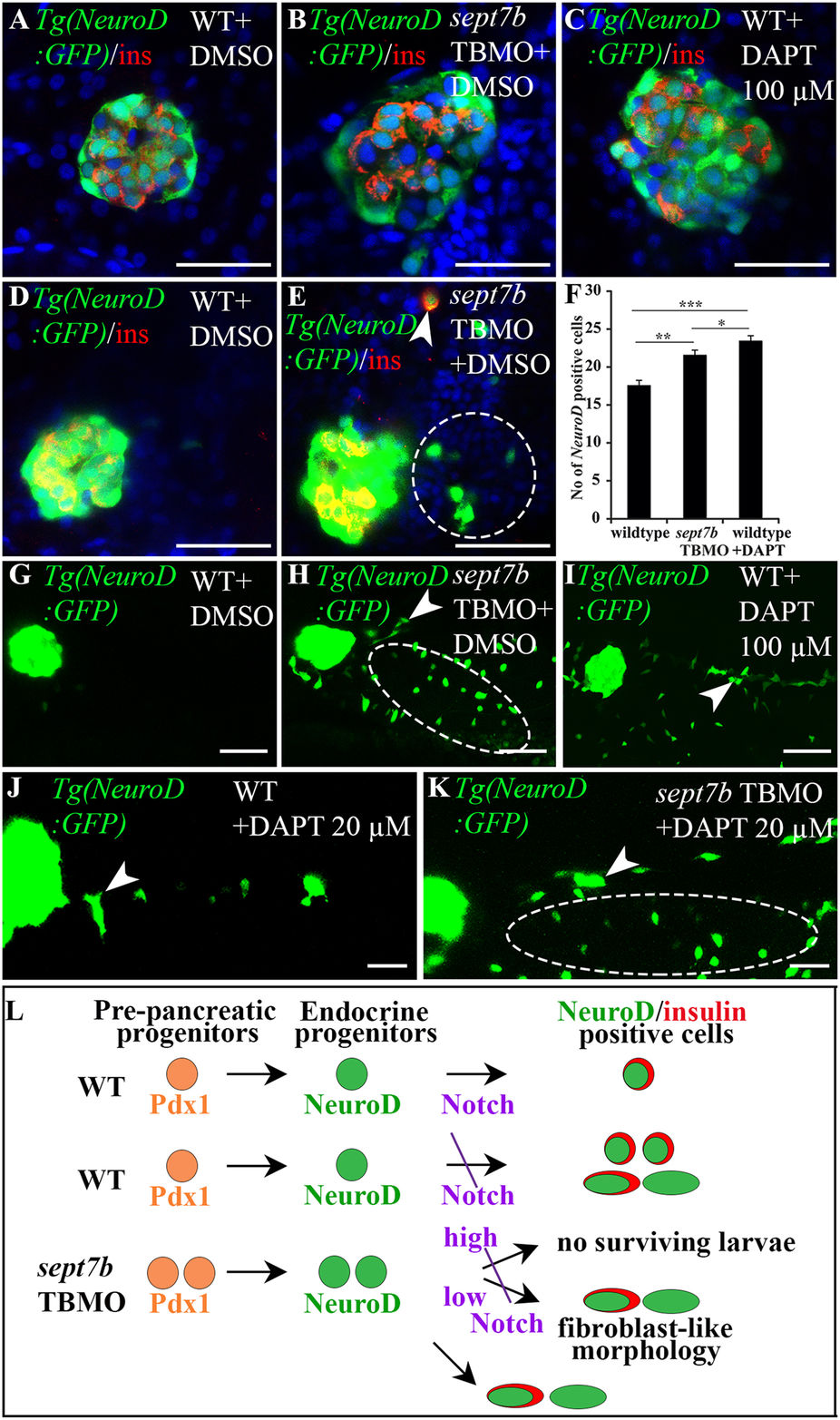Fig. 7
Endocrine progenitors are increased in islets, exocrine pancreas and gut epithelium in sept7b-depleted larvae.
(A–C) 5 dpf Tg(NeuroD:GFP) zebrafish larva treated with DMSO (A), sept7b TBMO (B), or 100 μM Notch-inhibitor DAPT (C) stained for insulin (red). (D,E) Enhanced exposure of 5 dpf Tg(NeuroD:GFP) larvae treated with DMSO (D) or sept7b TBMO (E) reveal excessive induction of NeuroD-positive cells in the extrapancreatic duct of sept7b-depleted larvae (circle). Occasional insulin and NeuroD double-positive cells (arrowhead) are observed in the intrapancreatic duct (IPD) of sept7b-depleted larva but not in controls. (F) NeuroD-positive endocrine cells are increased in sept7b TBMO- and 100 μM DAPT-treated larvae compared to DMSO-treated controls. (G–I) Enhanced exposures of 5 dpf Tg(NeuroD:GFP) larva treated with DMSO (G), sept7b TBMO (H), or 100 μM DAPT (I) reveal NeuroD-positive cells in exocrine pancreas (arrowhead) and gut epithelium (ellipse) in sept7b TBMO- and DAPT-treated larvae (H,I) but not in controls (G). (J,K) 20 μM DAPT causes NeuroD-positive endocrine cell formation (arrowhead) in the IPD and gut epithelium (ellipse) in sept7b-depleted larvae (K). Only few NeuroD-positive cells (arrowhead) are observed in the IPD of 20 μM DAPT-treated controls (J). (L) Schematic representation of pancreatic progenitor differentiation in wild type (WT), sept7b TBMO-treated and Notch-inhibited zebrafish larvae. In WT larva early Pdx1-positive pre-pancreatic progenitors give rise to late NeuroD-positive endocrine progenitors. Notch-responsive endocrine progenitors differentiate into NeuroD- and insulin-positive β-cells. Inhibition of Notch by 100 μM DAPT in WT larvae leads to differentiation of numerous NeuroD and insulin-positive progenitors in the islets. Notch inhibition also leads to emergence of NeuroD-positive cells in the pancreatic tail region, with fibroblast-like morphology. sept7b depletion leads to similar phenotype as inhibition of Notch: NeuroD-positive progenitors increase in the endocrine and exocrine pancreas, with fibroblast-type morphology. Treatment of sept7b-depleted larvae with 100 μM DAPT (high) leads to lethal toxicity, whereas 20 μM DAPT (low) is less toxic and the surviving larvae show induction of endocrine cells in the IPD and gut epithelium. Error bars represent mean ± SEM. *p ≤ 0.05; **p ≤ 0.01; ***p ≤ 0.005. Scale bar: (A–E) (25 μm); (G–I) (50 μm); (J–K) (30 μm).

